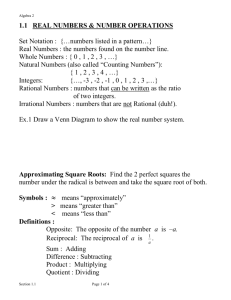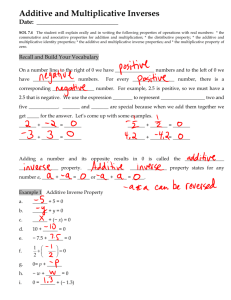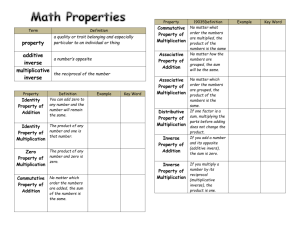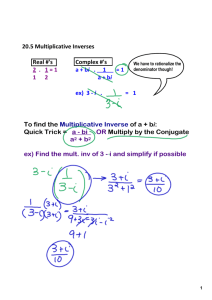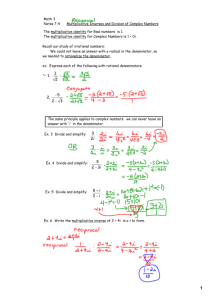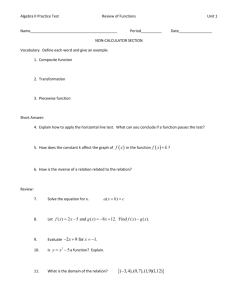Algebra 1 Unit 1
advertisement
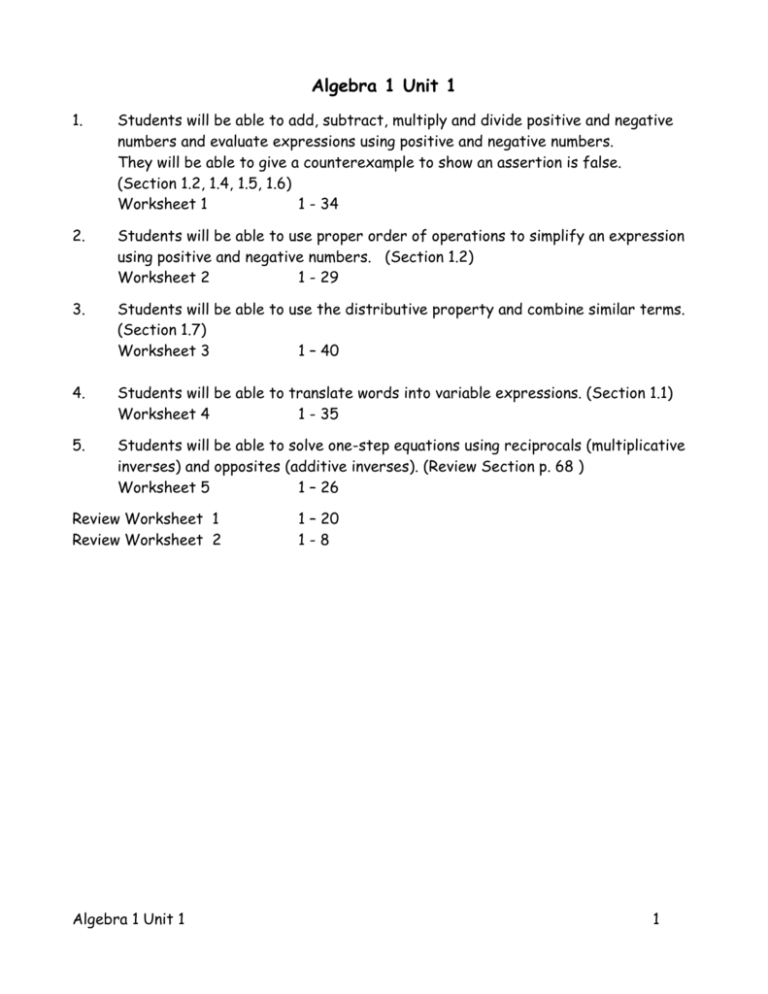
Algebra 1 Unit 1 1. Students will be able to add, subtract, multiply and divide positive and negative numbers and evaluate expressions using positive and negative numbers. They will be able to give a counterexample to show an assertion is false. (Section 1.2, 1.4, 1.5, 1.6) Worksheet 1 1 - 34 2. Students will be able to use proper order of operations to simplify an expression using positive and negative numbers. (Section 1.2) Worksheet 2 1 - 29 3. Students will be able to use the distributive property and combine similar terms. (Section 1.7) Worksheet 3 1 – 40 4. Students will be able to translate words into variable expressions. (Section 1.1) Worksheet 4 1 - 35 5. Students will be able to solve one-step equations using reciprocals (multiplicative inverses) and opposites (additive inverses). (Review Section p. 68 ) Worksheet 5 1 – 26 Review Worksheet 1 Review Worksheet 2 Algebra 1 Unit 1 1 – 20 1-8 1 Unit 1 Worksheet 1 Simplify: 1. 47 + (-86) 2. -6 – (-13) 3. -12(12) 4. -42 ÷ -3 5. (–2)(–5)(–6) 6. (12)(-2)(-5) 7. -9 + 15 – 7 – (-13) + 4 8. 0 10 9. 10 0 10. (-6)2 11. -62 12. –42 + (–4)2 13. 12 18 2 14. ( 4)( 5) 10 15. 12(5) 13 Evaluate each expression for x = 2, y = -5, z = -6 16. x y2 17. (xy)2 18. -z + y2 19. y–z 20. x2 + y2 21. (x + y)2 22. -z + 2y2 – x 23. x2 – y2 24. (x – y)2 25. (2y)3 26. z2 – y 27. xz 4 Algebra 1 Unit 1 2 Complete each table 28. n work -4n -5 -1 0 8 29. 30. p work 9–p 15 4 -2 -7 m work -3m+4 -4 -2 5 6 31. A scuba diver is 74 feet below sea level. He begins to rise and ascends 12 feet. Find the new depth after rising. 32. A football team loses 9 yards on their first play. On the next two plays they gain 4 yards and then gain 15 more. What is the end result? (How many total yards have they either gained or lost?) 33. The chart shows an expression evaluated for four different values of x. Looking at the chart Carol concluded that x2 > x. Which value of x serves as a counterexample to prove Carol’s conclusion false? A. –9 B. 8 C. 0 D. 11 34. Which number serves as a counterexample to the statement below? x –12 –5 2 10 The value of x2 – 4 is always positive. A. B. C. D. 7 –6 3 1 Algebra 1 Unit 1 3 x2 144 25 4 100 Unit 1 Worksheet 2 Simplify each expression using proper order of operations. 1. 22 – 8 ÷ 2 2. –92 3. (–9)2 4. –72 + 72 5. 2 • 32 6. (2 • 3)2 7. 3 • 52 + (3 • 5)2 8. 6 + 2(4) 9. 4 + 5(8 + 1) 10. 12 – 6(5)2 11. 6 – 2(1 + 4) 12. 3 + 6(10 – 4) 14. [8 + 2(3 – 5)] – 6 15. 17. 2 -5 18. 13. 16. 5 8 5 8 9 5 -32 2 4 - 16 20 8 11 25 - 42 ÷2 Explain the error in the following problems and then work the problem correctly. 16. 16 + 16 ÷ 4 17. 17 – 3 + 2 18. 3(2 + 7) = 32 ÷ 4 = 17 – 5 = 6+ 7 = 8 = 12 = 13 19. –12 ÷ 2 + 2 = 6 + 2 = 8 Algebra 1 Unit 1 20. 4 + 3(6 + 4) = 7(6 + 4) = 7 (10) = 70 21. 4(–3) + (–6)(2) = –12 + (–6)(2) = –18(2) = –36 4 22. Four students simplified the problem below. Which student worked it correctly using proper order of operations? Alice 4 + 2(3 + 5) = 6(3 + 5) = 6(8) = 48 Beth 4 + 2(3 + 5) = 6(3 + 5) = 18 + 5 = 23 Cathy 4 + 2(3 + 5) = 4 + 2 (8) = 4 + 16 = 20 Darla 4 + 2(3 + 5) = 4+ 6 + 5 = 10 + 5 = 15 Answer the following statements as true or false. If false give one counterexample to support your answer. 23. The order in which two numbers are added does not affect the sum. 24. The order in which two numbers are subtracted does not affect the difference. 25. The order in which two numbers are divided does not affect the quotient. 26. The sum of zero and a number will equal the number. 27. The order in which two numbers are multiplied does not affect the product. 28. The product of zero and a number will equal the number. 29. The product of one and a number will equal the number. Algebra 1 Unit 1 5 Unit 1 Worksheet 3 Simplify the following expressions by combining like terms: 1. 3a + 2a 2. 7e – 5e 3. 8y + 3y – 5y 4. 2a + 3 + 4a + 5 5. 3d – 2 + 18 + 4d 6. x + 3x + 6 7. 9 + 6x + 2x 8. 9x + 3 + 7x + 4 9. 2y + 7 + y + 9y + 4 10. 9 + 6u – 31 + 8u 11. x+2+x+9 12. –x + 3 + 4x – 12 Use the distributive property and simplify when needed. 13. –2(x + 3) 14. 7(3y – 8) 15. –3(4m – 6) 16. 5( –x + 7) 17. –(–5h – 9) 18. 6(x – 4) 19. 1 (10x + 12) 2 20. 1 (18x – 24) 3 21. 3 (4x + 8) 4 22. 3(x + 4) + 5(2x + 7) 23. 9(x + 3) – 7(x – 2) 24. 3(4p + 3) + 4(p – 1) 25. -3(2x + 4) + 26. 4(x + 2) – (x + 6) 27. 1 (10x – 5) – (2x–3) 5 Algebra 1 Unit 1 1 (2x – 4) 2 6 28. 5(2m + 5) – 6 29. 9(8x – 5) – 10 30. 5(2 + x) + 7x 31. 2 + 5(3x – 4) 32. 4 + 2(7x + 1) 33. 7 – 3(x + 9) 34. 8 – (10x – 5) 35. 10 – 8(x – 3) 36. 5+ 1 (8x + 6) 2 Select the correct multiple choice response: 37. Which shows the proper use of the distributive property? A. –3(x + 2) = –3x + 2 B. –3(x + 2) = –3x + 6 C. –3(x + 2) = –3x – 2 D. –3(x + 2) = –3x – 6 38. Which shows the proper use of the distributive property? A. – (y – 7) = –y + 7 B. – (y – 7) = –y – 7 C. – (y – 7) = y + 7 D. – (y – 7) = y – 7 39. Is the equation 5(7x – 6) = 2 equivalent to 35x – 30 = 2 ? A. No, they are not equivalent. It should be 35x – 6 = 2 B. Yes, they are equivalent by the Distributive Property C. No, they are not equivalent. It should be 35x – 30 = 10 D. No, they are not equivalent. It should be 12x – 6 = 2 40. What should be done first when simplifying 6 + 3(2x – 1) ? A. Add the 6 and 3 B. Subtract the 2x and 1 C. Distribute the 3 to the 2x – 1 Algebra 1 Unit 1 7 Unit 1 Worksheet 4 In problems 1 – 19, translate each phrase into a mathematical expression: 1. Twice a number, w 2. The square of v 3. The cube of m 4. Triple k 5. Double y 6. Five less than x 7. The quotient of c and 4 8. Four more than half a number 9. Two less than the cube of x 10. Six decreased by the triple of d 11. Square a number and diminish by 2 12. The product of 8 and the cube of k 13. 5 less than the product of 3 and m 14. The square of x diminished by the cube of y 15. The reciprocal of x increased by twice the square root of x 16. The sum of x and the opposite of d 17. The product of 5 and the reciprocal of y 18. The additive inverse of 5 diminished by the square root of m 19. The product of y and its reciprocal Answer the questions in problems 20 - 22 20. What is another word for reciprocal? 21. What is another word for opposite? 22. What number does not have a reciprocal? Algebra 1 Unit 1 8 Complete the chart for problems 23 – 28. Additive inverse Multiplicative inverse (opposite) (reciprocal) 23. 5 24. –7 25. 2 3 26. 0 27. 3 5 28. 1 Select the correct multiple choice response in problems 29 – 32. 29. Which is an algebraic expression for: the sum of 7 and x? A. 30. 31. 7x B. 7–x C. What is the additive inverse of –w ? 1 A. B. w C. w What is the multiplicative inverse of 0? A. 1 B. –1 C. 7 x 7+x D. –w D. – 0 D. none of these 32. What is the sum of a number, x, and its opposite? A. 1 B. –1 C. 0 D. x 33. What is the product of a number, x, and its reciprocal? A. 1 B. –1 C. 0 D. x 34. Which shows the proper use of the distributive property? A. 2(3x + 6) = 5x + 5 B. 2(3x + 6) = 5x + 12 C. 2(3x + 6) = 6x + 6 D. 2(3x + 6) = 6x + 12 35. What is the reciprocal of 12p ? 12 A. B. –12p p Algebra 1 Unit 1 C. –12 – p D. 1 w 1 12p 9 Unit 1 Worksheet 5 Solve using the additive inverse (opposite) 1. x+4=–9 2. x + 8 = -5 Solve using the multiplicative inverse (reciprocal) 2 4. -5x = -20 5. x = 24 3 Solve using the additive inverse or multiplicative inverse. x 7. x – -9 = 12 8. = 6 3 3. 21 + x = 14 6. -8 = 9. 3x = 6 x 2 10. 3+x= 1 11. -x = 30 12. x 5 13. x = -12 4 14. 2 x = 6 3 15. 3 x=1 4 16. -5x = 30 17. 4 x=1 5 18. – Algebra 1 Unit 1 = 10 4 x = 12 3 10 19. 18x = 0 20. 3 x=1 7 21. x = 0 4 22. 3 x = -24 4 23. -x = -7 24. x = 7 7 25 What is the solution to – A. 9 7 B. – C. D. 26. 7 x = 1 9 9 7 7 1 9 2 9 Which multiple choice describes the correct way to solve the equation: 2 x = -40 5 A. Add the opposite to both sides B. Subtract the opposite from both sides C. Multiply both sides by the multiplicative inverse D. Divide both sides by -40 Algebra 1 Unit 1 11 Unit 1 Review 1 Simplify problems 1 – 9. 1. 6 + 3(2 + 1) 2. 5 0 3. 0 5 4. –82 + (–8)2 5. 2 • 52 + (2 • 5)2 6. 4 + 3(7 + 1) 7. –5(3x + 7y) – 8(2x – 3y) 8. 2 (6x + 9y) – (5x – 10y) 3 9. 5 – 2(4x + 5) Answer individual questions in problems 10 – 16. State the opposite of 4 5 10. What is the reciprocal of 9w ? 11. 12. State the additive inverse of – 4k 13. State the multiplicative inverse of –8k 14. What number does not have a reciprocal? 15. What is the sum of a number and its opposite? 16. What is the product of a number and its reciprocal? Find the value of x in problems 17 and 18 x 3 17. = –10 18. x=1 10 4 In problems 19 and 20 give a counterexample to the statement. 19. The sum of two numbers is always positive. 20. When x2 + 2x is evaluated for all numbers the answer will always be an even number. Algebra 1 Unit 1 12 Unit 1 Review 2 Select the correct multiple choice response: 1. What is the additive inverse of A. 3 2 B. – C. 2 3 D. – 2 ? 3 3 2 2 3 2. Which statement is true? A. x + x = x2 B. x + x = 2x C. –x2 = x2 1 D. x( )=x x 3. Amy simplified the expression below. In which step did she first make a mistake? 2 + 3(1 + 4) Step 1 Step 2 Step 3 A. B. C. D. 4. 2 + 3 (5) 5 (5) 25 Step 1 Step 2 Step 3 Amy did not make a mistake Simplify: -2(x – 3y) + 4(5x + 6y) A. 18x + 30y B. 18x + 18y C. -22x + 18y D. -18x + 18y Algebra 1 Unit 1 13 5. What is the multiplicative inverse of –9k ? A. 9k 1 B. 9k 1 C. – 9k D. 1 6. x2 is never negative When is this statement true? A. This statement is never true B. This statement is only true for positive numbers. C. This statement is always true. D. There is not enough information to tell 7. Which number serves as a counterexample to the statement below? When evaluating (2x + 5) your answer is always greater than 0 A. B. C. D. 8. 5 –7 –1 0 What is the value of x? A. B. C. D. 5 8 3 8 8 5 5 –1 8 5 x=1 8 1 Algebra 1 Unit 1 14
